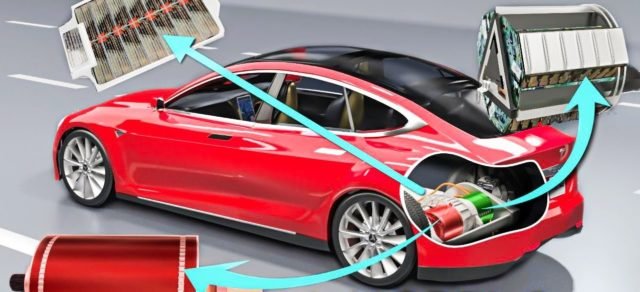Why are electric cars such a big deal ? Are they really better than today’s gasoline powered ones? Well, we’ll see.
Electric vehicles or EVs are getting popular day by day. Most of them know about electric cars by knowing Tesla Motors, one of the leading manufacturer of electric cars.
The 2018 Tesla Roadster goes from 0-100 km/hr in just eye-popping 1.9 seconds & its the fastest production car in the world!
Wondering how does that even happen? Hah, welcome to the future, reader! The whole article is about to answer your questions.
So lets get going and know how do electric cars work?

Here are top 10 mind blowing facts of Tesla Roadster !
Electric Vehicles –
EVs existed even 100 years ago; they existed since mid 1800s but the didn’t gain much popularity even though they were preferred. The electric vehicles back then could not provide a level of comfort and power than the ones with internal combustion engine gave. The batteries those days weren’t advanced which led to battery storage issues.
Today’s safer electric circuits, technological progresses in computers & focus on renewable energy resources have made it possible to make EVs even better than the gasoline cars.
There are basically 3 components in an electric car which differentiates itself from the modern gasoline cars. The 3 components are –
1. Battery –
Batteries are the powerhouses of EVs, a substitute for fuel. Batteries used are made of dozens of small Lithium-ion(Li-ion) cells packed together in a box called as battery pack. Despite being the most expensive in the market, Lithim-ion batteries are preferred instead of Lead acid or Nickel-Cadmium (Ni-Cd) because of their numerous perks. Li-ion batteries have high energy density (can store more energy per kg). Smaller cells packed together gives another advantage of being able to dissipate the heat efficiently.
The same batteries are used in our trimmers, mobile phones, toys, laptops…you name it. Battery packs are generally located at the bottom of the cars to lower the centre of gravity but few auto manufacturers prefer to keep in the trunk. Batteries not only power the motors but also wipers, headlights, air conditioners etc.
2. Motors –
Generally, BLDC (Brushless DC motors) or 3 phase AC induction motor are used in EVs. Forklifts and other low power vehicles and applications operate on BLDC motors. Induction motors are simply preferred in cars because they offer highest efficiency among any other motors! An inverter is required since the induction motor demands AC current while our batteries supply DC current. Electric motors produce much higher torque than normal engines!
3. Controller –
Controller is the brain of EVs. It does what you tell it to do & also takes its own decision to improve performance & driving experience. It understands how much throttle you have given and supplies more power to the motor accordingly. All the other functions like limiting torque, ABS system, lane keeping, automatic parking are processed by microprocessor and the controller guides the vehicle as per the algorithm.
How do electric cars work ?
Electric vehicles take power from the batteries in the form of electrical energy and is supplied to electric motors via a controller thereby converting into mechanical work.
They work in similar manner to our remote controlled toys.

1.When you push the accelerator pedal, the transducer connected to it sends the position to the processor.
2.The position of pedal is associated with the power given by the battery to the motor. The position value is calibrated accordingly & this information is sent to the controller.
3.Since the batteries supply only direct current, it is further connected to inverter. The inverter further converts the direct current into alternating current. The controller already has the information to how much power to be supplied.
4.The power supplied to the motor gets converted into mechanical energy. Simple, that’s it.
5.The processor keeps an eye on everything in the car and notifies the driver when something’s need to be looked upon. The dashboard always shows the range of car with the current amount of charge remaining in battery pack.
6.If your purpose is for daily use then just plug in your car while you sleep at night and forget it. The modern circuits doesn’t let the car overcharge.
Cool, right? While if your journey is longer, you could locate a supercharging station and get it charged up to 50% in just 20 mins OR get it fully charged while you take some rest 😀
DID YOU KNOW – The batteries get charged when you apply brakes! This is called Regenerative braking. Regenerative braking converts the kinetic energy of the vehicle at the time of braking into chemical energy stored in the battery.
Regenerative braking systems are able to recover approximately 60% of the braking energy.
So what do you think? Are electric cars really the future of automobiles ? Let me know in the comments and we can have a really good discussion.. 🙂


3 comments on “How do electric cars work ? | Tesla cars”
The idea of transmitting energy from a battery to drive the vehicle is great. But why not fit a dynamo of some sort to one of the wheels and put the energy back into the batteries as you are driving along. I’m sure some vehicles have this in some shape or form but why hasn’t Tesla got this design in their vehicles.
Hi John, you are on the right track. I appreciate your thoughts. This technique is already been implemented in Tesla as well as other EVs. It is called Regenerative braking. Refer the 2nd last para for more 🙂
How is the actual speed changed by changing the frequency and voltage output of the inverter?Worked on RR where AC locomotives have been used for some time.